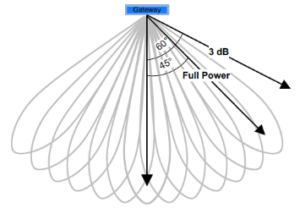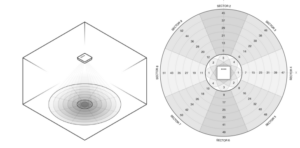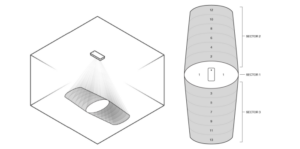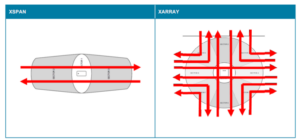Can UHF RFID be used for high-precision positioning?
Let me first give you the answer. UHF RFID can be used for high-precision positioning, but the accuracy is about 1 meter.
UHF RFID is used as a positioning solution. The core device is the reader using a phased array antenna. The principle of phased array antenna is described in detail in Gan Quan’s book “UHF RFID Technology Products and Applications for the Internet of Things”. We will quote the relevant content.
Principle of Phased Array Antenna
Phase array antenna, also known as phased array antenna, refers to an antenna that changes the shape of the directional pattern by controlling the feeding phase of the radiating unit in the array antenna. Controlling the phase can change the direction of the maximum value of the antenna directional pattern to achieve the purpose of beam scanning. It can be simply understood that the traditional antenna has only one fixed radiation pattern, while the array antenna can have multiple radiation patterns in different directions. When a phased array antenna is used in an ultra-high frequency RFID system, one antenna can be transformed into multiple antennas in different directions. The following figure shows the radiation diagram of a gateway with a phased array antenna. The original antenna main lobe radiation axis θ=0°. After the phase of the specified radiation unit in the array antenna is adjusted, the main lobe radiation axis will deflect, and the maximum deflection can be 45°. Compared with the traditional solution, the coverage of the phased array gateway using the solution shown in the figure below has been greatly increased. The original 3dB radiation angle was 30°, and now it has become 120°.

Phased array antenna gateway radiation diagram
The specific operation of the phased array gateway can be understood as a single-port reader becoming a multi-port reader (how many combinations of phases correspond to how many ports). The original single-port reader can only connect to one antenna, and the radiation range is fixed, while the multi-port reader can connect to many antennas, and each antenna has a different radiation range. This multi-port reader can select the area to be scanned according to the needs and start the corresponding port to transmit the signal through the corresponding antenna to cover the specified area.
Phased array antenna positioning function
Regarding the positioning function of UHF RFID readers, take two common phased array gateways on the market: Impinj’s xSpan and xArray as examples.
xArray is a square phased array gateway. When the xArray is hung on the roof, its coverage area is a circle, with a total of 8 sectors and 52 radiation areas. It can be simply understood as a 52-port reader connected to 52 antennas with different radiation areas.

xArray beam pattern
xSpan is a rectangular phased array gateway. The xSpan gateway can be seen as a simplified version of the xArray. When the xSpan is hung on the roof, the area it covers is a rectangle with a total of 13 radiation areas. It can be simply understood as a 13-port reader connected to antennas in 13 different radiation areas.

xSpan beam pattern
In the actual environment, the radiation areas of adjacent numbers overlap each other. When the same tag is identified in multiple numbered radiation areas, the specific location of the tag can be calculated by the RSSI size. The calculation process is to convert the RSSI difference into the distance difference, and then implement it through the multi-point positioning algorithm. Of course, the tag is likely to fall in the radiation area with the largest RSSI value.
The biggest function of the phased array gateway is positioning, judging the location and movement of the object. The following figure shows the tag movement that can be tracked by xSpan and xArray. Among them, xSpan can only track the tag movement in one axis direction, while xArray can track tags moving in multiple different directions.

Phased array gateway direction tracking
In order to ensure the real-time tracking of objects, it is necessary to ensure that the antenna switching speed is fast enough. Even if the switching is 50ms each time, it takes 2.5s to scan all the radiation areas of the xArray. Therefore, in the application of object tracking, the number of tags in the field should be guaranteed. If high-precision tracking is required, the number of tags should not exceed 20; if high-speed tracking is to be achieved, the number of tags should not exceed 50.
In actual tests, there are certain errors due to various reasons. The measured data in an ideal environment without occlusion and reflection is: there is an 85% probability error within 1.5 meters. The error will be greater in complex environments, especially in retail stores with shelf and wall reflections, as well as the stacking and placement height of tags, which will have a great impact on the test accuracy. However, compared with traditional technologies, the use of phased array gateways greatly improves the accuracy and convenience of object positioning and finding.
The optimization of positioning accuracy by the research team of Shanghai Jiaotong University is mainly reflected in the algorithm level. In their solution, they first need to read the phase information of the tag reflection signal through the reader array antenna of manufacturers such as Impinj, and then optimize the positioning algorithm based on the phase information.
The centimeter-level positioning accuracy reported in the news before is the effect achieved under relatively ideal conditions. To achieve such accuracy, many specific conditions are required. If it is in a general environment, based on the optimization of the algorithm, it is a major breakthrough to improve the positioning accuracy of the UHF RFID positioning solution from about 1 meter to decimeter level.
What scenarios are suitable for UHF RFID high-precision positioning
The positioning accuracy of UHF RFID is about 1m, which also belongs to the category of high-precision positioning technology. At present, the wireless positioning technology with the best positioning accuracy on the market is UWB, which can achieve centimeter-level positioning accuracy in an ideal environment, but in actual applications, it is likely to be decimeter-level; while the positioning accuracy of Bluetooth AoA is only meter-level, and the accuracy of Bluetooth’s next-generation positioning technology “Channel Sounding” is also about 1m, so the positioning accuracy of UHF RFID is not bad.
